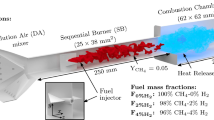A study has been made of the influence of a porous obstacle on deflagration-to-detonation transition in a pulse combustion chamber of small length. Dependences of the detonation-wave velocity on the distance have been obtained for two samples of a porous material (steel spheres and a ceramic porous body). It has been shown that the use of an insert from a porous material leads to a reduction of 40% in the predetonation distance without changing substantially the structure of the pulse combustion chamber.
Similar content being viewed by others
References
S. Eidelman and X. L. Yang, Analysis of the pulse detonation engine efficiency, AIAA, 137–146 (1998).
R. Mohanraj and C. L. Merkle, A numerical study of pulse detonation engine performance, AIAA, 176–185 (2000).
S. Yungster, Analysis of nozzle effects on pulse detonation engine performance, AIAA, 94–105 (2003).
S. M. Frolov (Ed.), Pulse Detonation Engines [in Russian], Torus Press, Moscow (2006).
G. D. Roy, S. M. Frolov, A. A. Borisov, and D. W. Netzer, Pulse detonation propulsion: challenges, current status, and future perspective, Prog. Energy Combust. Sci., 30, No 6, 545–672 (2004).
A. A. Borisov, A. F. Galkin, V. K. Zhivotov, et al., Influence of the corona discharge on the process of detonation initiation by a weak energy source, Khim. Vys. Énerg., 41, No. 5, 418–422 (2007).
W. H. Heiser and D. T. Pratt, Thermodynamic cycle analysis of pulse detonation engines, J. Propuls. Power, 18, No 1, 68–76 (2002).
Ya. B. Zel’dovich, On the problem of power-related use of detonation combustion, Zh. Tekh. Fiz., 10, No. 17, 1453–1461 (1940).
Ya. B. Zel’dovich and A. S. Kompaneets, The Theory of Detonation [in Russian], Gostekhizdat, Moscow (1955).
S. M. Frolov, I. V. Semenov, P. V. Komissarov, et al., Reduction of the length and time of deflagration-todetonation transition in a pipe with profiled regular barriers, Dokl. Ross. Akad. Nauk, 415, No. 4, 509–513 (2007).
A. G. Kutushev and L. V. Shorokhova, Numerical investigation of the processes of combustion and detonation of aerosuspensions of a unitary fuel in abruptly expanding pipes, Khim. Fiz., 22, No. 8, 94–99 (2003).
R. Hillier, Computation of shock wave diffraction at a ninety degrees convex edge, Shock Waves, 1, 89–98 (1991).
B. Y. Wang, Q. S. Wu, C. Wang, O. Igra, and J. Falcovitz, Shock wave diffraction by a cavity filled with dusty gas, Shock Waves, 11, 7–14 (2001).
Author information
Authors and Affiliations
Corresponding author
Additional information
Translated from Inzhenerno-Fizicheskii Zhurnal, Vol. 85, No. 5, pp. 968–973, September–October, 2012.
Rights and permissions
About this article
Cite this article
Alhussan, K., Assad, M.S., Penyazkov, O.G. et al. Formation of detonation in a pulse combustion chamber with a porous obstacle. J Eng Phys Thermophy 85, 1052–1057 (2012). https://doi.org/10.1007/s10891-012-0746-2
Received:
Published:
Issue Date:
DOI: https://doi.org/10.1007/s10891-012-0746-2




